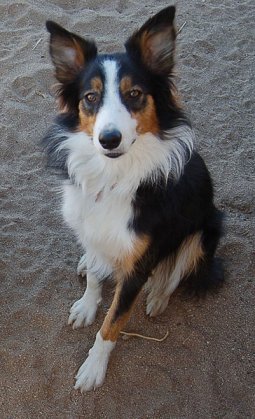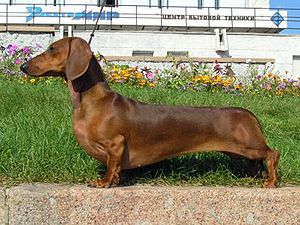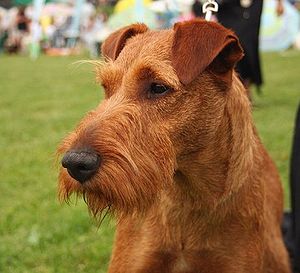 |
| Vital Statistics: |
| Place of Origin: Scotland, England, Wales |
| Group: Herding dog |
| Height: males 19-23 in., females 18-21 in. |
| Weight: males 30-45 lbs., females 27-42 lbs. |
| Life span: 12-13 yrs. |
| Trainability: high |
| Good with children: yes with older children |
| Good with other pets: dogs & cats if raised with them, may chase small animals |
April’s Dog of the Month
The Border Collie is thought to be the most intelligent of dog breeds. Originally from England, these dogs are incredible herders.
What is the origin of the Border Collie?
In the 1800s, there were a variety of sheep-herding dogs in Great Britain. A dog named Hemp stared the sheep down as opposed to barking and nipping constantly. Because of this trait, Hemp was bred and became the father of Border Collies.
What does the Border Collie look like?
The Border Collie is medium size, 18-23 inches tall and 27-45 lbs. depending on gender. Ears are erect or semi erect. Eyes are dark except blue merles may have blue eyes. Feet are oval. The tail is carried low. The medium length rough coat is flat or slightly wavy. The smooth coated variety is short. Both have a dense undercoat. Colors are solid, bi color, tricolor, merle and sable. Regular brushing and combing will keep the coat clean and glossy.
What is the temperament of the Border Collie?
The Border Collie is a dog that needs a job. With its high energy level, the Border Collie should have lots of exercise and mental stimulation. It is very intelligent and learns quickly. Early training with a firm but kind hand is necessary. The Border Collie needs an energetic owner who will work the dog daily. If it becomes bored, this dog will display unwanted behavior. Apartments are not good homes for Border Collies. With the right owner, Border Collies are wonderful pets.
What is the Border Collie used for?
The Border Collie is an outstanding herding dog. They do well in agility, obedience and tracking trials. They have been used as search and rescue dogs.
Possible Health Issues
Hip and elbow dysplasia, collie eye anomaly (parts of eyes don’t develop normally), epilepsy, progressive retinal atrophy, osteochondritis dissecans.
- Australian Cattle Dog
- Australian Kelpie
- Australian Shepherd
- Bearded Collie
- Beauceron
- Belgian Sheepdog – Groenendael
- Belgian Tervuren
- Bergamasco
- Berger Picard
- Blue Lacy
- Bouvier des Flandres
- Briard
- Cardigan Welsh Corgi
- Catahoula Leopard Dog
- Collie
- English Shepherd
- Entlebucher
- Finnish Lapphund
- German Shepherd
- Hovawart
- Icelandic Sheepdog
- Laika
- Lancashire Heeler
- Miniature American Shepherd
- Mudi
- Old English Sheepdog
- Pembroke Welsh Corgi
- Polish Lowland Sheepdog
- Puli
- Pumi
- Pyrenean Shepherd
- Shetland Sheepdog
- Standard Schnauzer
- Swedish Vallhund
- Airedale Terrier
- Beagle
- Bedlington Terrier
- Bluetick Coonhound
- Border Terrier
- Bull Terrier
- Bulldog
- Bullmastiff
- Ca de Bou
- Cavalier King Charles Spaniel
- Clumber Spaniel
- Collie
- Curly-coated Retriever
- Dandie Dinmont Terrier
- English Cocker Spaniel
- English Foxhound
- English Setter
- English Springer Spaniel
- English Toy Terrier
- Flat-coated Retriever
- Golden Retriever
- Greyhound
- Harrier
- Jack Russell Terrier
- Lakeland Terrier
- Lancashire Heeler
- Llewellyn Setter
- Manchester Terrier
- Mastiff
- Norfolk Terrier and Norwich Terrier
- Old English Sheepdog
- Old English Terrier
- Otterhound
- Parson Russell Terrier
- Shetland Sheepdog
- Smooth and Wire-haired Fox Terrier
- Sussex Spaniel
- Welsh Terrier
- Whippet
- Wire Fox Terrier
- Yorkshire Terrier



